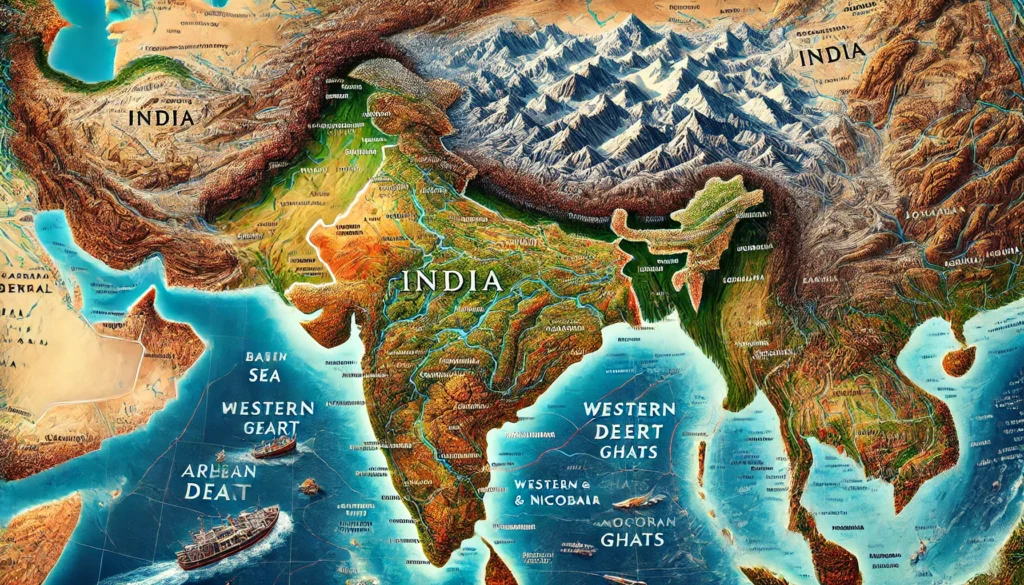
Geography of India is extremely diverse and unique. Its area is approximately 32,87,263 square kilometers , making it the seventh largest country in the world. Various geographical features such as mountains, plateaus, plains, deserts, beaches and islands are located here. Let us understand the geography of India in major aspects :
1. Location and extent
- Location : India is located in the Northern Hemisphere and lies approximately between 8°4′ North latitude to 37°6′ North latitude and 68°7′ East longitude to 97°25′ East longitude.
- Limit :
- Himalaya Mountains in the north.
- Pakistan and the Arabian Sea to the west.
- Bangladesh , Myanmar and the Bay of Bengal in the east.
- Indian Ocean to the south.
- Neighbouring countries : Pakistan , China , Nepal , Bhutan , Bangladesh , Myanmar and Sri Lanka ( via sea ) .
2. Geographical area
India can be divided into five main geographical regions :
(i) Himalayan region
- Location : Located in Northern India.
- Feature : It is home to the Himalayan mountain range , which includes some of the world’s highest peaks such as Mount Everest ( in Nepal ) and Kanchenjunga.
- Rivers : Source of major rivers like Ganga , Yamuna , Brahmaputra.
- Importance : Climate control , natural protection and conservation of vegetation.
(ii) Northern Plains
- Location : This region formed by rivers like Ganga , Yamuna and Brahmaputra is spread in northern and eastern India.
- Features : Extremely fertile , suitable for agriculture ( Ganga – Brahmaputra delta is the largest delta in the world ) .
- Crops : Paddy , wheat , sugarcane and pulses.
(iii) Peninsular Plateau
- Location : In central and southern India.
- Specialty : This area is rich in ancient rocks and mineral resources. Vindhya and Satpura mountains are located here.
- Rivers : Narmada , Tapti ( west flowing rivers ) and Godavari , Kaveri , Krishna ( east flowing rivers ) .
- Minerals : Iron , bauxite , coal , and gold.
(iv) Thar Desert
- Location : In the western part of Rajasthan and Gujarat.
- Features : Dry climate , sand dunes , and drought – resistant crops.
- Irrigation Project : Indira Gandhi Canal ( to promote agriculture in the Thar region ) .
(v) Coastal areas and islands
- Coastal Areas :
- Western Coast ( Kutch to Kanyakumari ) .
- East Coast ( Sundarbans Delta to Kanyakumari ) .
- Islands :
- Andaman and Nicobar Islands ( in the Bay of Bengal ) .
- Lakshadweep ( in the Arabian Sea ) .
3. Climate
The climate in India is classified into five main types of meteorology It is divided into :
- Tropical monsoon climate.
- Temperate climate ( in mountainous areas ) .
- Dry climate ( Thar Desert ) .
- Subtropical climate ( North India ) .
- Equatorial climate ( southern regions and islands ) .
4. Rivers
India is also called the ” land of rivers ” . The rivers here are divided into two main categories :
- Himalayan Rivers : Ganga , Yamuna , Brahmaputra.
- Peninsular Rivers : Narmada , Godavari , Kaveri , Krishna.
5. Forests and vegetation
- Forests cover about 21.71% of the land in India .
- Major forest types :
- Tropical rain forest.
- Dry deciduous forest.
- Mountain forests.
- Mangrove forest ( Sundarbans ) .
6. Natural resources
is rich in minerals , water , forests , and agricultural resources.
- Minerals : Coal , Iron , Manganese , Bauxite , Gold.
- Energy sources : Hydroelectricity , solar energy , wind energy.
7. Geographical importance
- India’s location makes it central to Asian and world trade routes.
- Its diverse geographical landscape and climate make it ideal for agriculture , mining , tourism , and business.
Location and Boundary of India
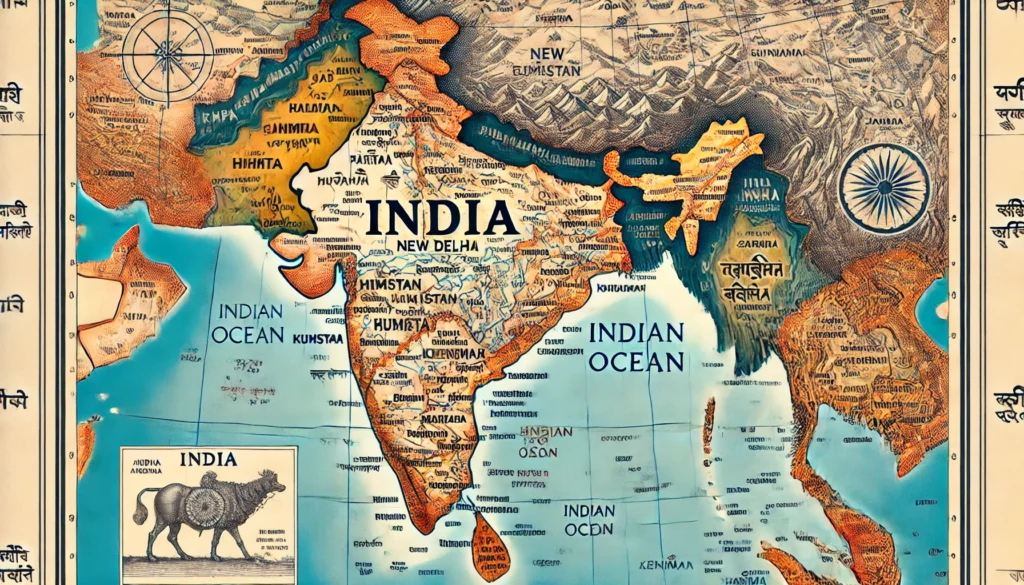
India is a country with unique characteristics due to its geographical location and extent. It is located in South Asia and due to its geographical location it is called ” Heart of Asia “ It is also called.
Location
Latitudinal Extension :
- India is located between 8°4′ North latitude and 37°6′ North latitude.
- makes it located in the Northern Hemisphere .
Longitude Extension :
- India extends between 68°7′ East longitude and 97°25′ East longitude.
- Indian Standard Time (IST) is based on 82°30′ East longitude , which is located in the middle of the country.
Tropic of Cancer ( Tropic of Cancer ) :
- The Tropic of Cancer (23°30′ North latitude ) passes through the middle of India. It divides India into northern and southern parts divides it into .
- passes through Gujarat , Rajasthan , Madhya Pradesh , Chhattisgarh , Jharkhand , West Bengal , Tripura and Mizoram.
Geographical Location :
- India is located in the southern part of Asia.
- Its southern part extends to the Indian Ocean , making it an important centre for maritime trade.
Boundary
India’s borders are surrounded by various land areas and countries on all sides. Its borders are of three types : land border , sea border , and island border .
1. Land Boundary
- India’s land border is approximately 15,106 kilometers It is long.
- Many countries are located in the north , north – west and north – east of India .
- Neighbouring countries and their borders :
- Pakistan : 3,323 km ( borders on Jammu and Kashmir , Punjab , Rajasthan and Gujarat ) .
- China : 3,488 km ( borders on Ladakh , Himachal Pradesh , Uttarakhand , Sikkim and Arunachal Pradesh ) .
- Nepal : 1,751 km ( borders on Uttarakhand , Uttar Pradesh , Bihar , West Bengal and Sikkim ) .
- Bhutan : 699 km ( borders on Sikkim , West Bengal , Arunachal Pradesh and Assam ) .
- Bangladesh : 4,096 km ( bordering West Bengal , Assam , Meghalaya , Tripura and Mizoram ) .
- Myanmar : 1,643 km ( bordering Arunachal Pradesh , Nagaland , Manipur and Mizoram ) .
2. Coastal Boundary
- India has a maritime border of approximately 7,516.6 km It is long.
- Sea on all three sides :
- West : Arabian Sea.
- East : Bay of Bengal.
- South : Indian Ocean.
- Coastal states : Gujarat , Maharashtra , Goa , Karnataka , Kerala , Tamil Nadu , Andhra Pradesh , Odisha and West Bengal.
- Islands : Andaman and Nicobar Islands ( in the Bay of Bengal ) and Lakshadweep ( in the Arabian Sea ) .
3. Island Boundary
- India has two major island groups :
- Andaman and Nicobar Islands (572 islands ): In the Bay of Bengal.
- Lakshadweep Islands (36 islands ): In the Arabian Sea.
- These islands are very important from strategic point of view.
Important facts related to India’s border
Importance of maritime trade :
India’s maritime position makes it a centre of trade between the countries of the East and West.
Border Security :
- There are many military posts on the border of India.
- The disputed areas in the Himalayan region with China ( Aksai Chin and Arunachal Pradesh ) and the Line of Control (LOC) of Jammu and Kashmir with Pakistan are sensitive areas.
International Relations :
- India is continuously making efforts to maintain bilateral relations with its neighboring countries.
- SAARC and BIMSTEC India has an important role in such organizations.
Geographical Importance
The geographical location and extent of India makes it an important strategic and economic centre at the southern tip of Asia. It strengthens the country’s diversity , business power and geopolitical position .
The geographical Area of India
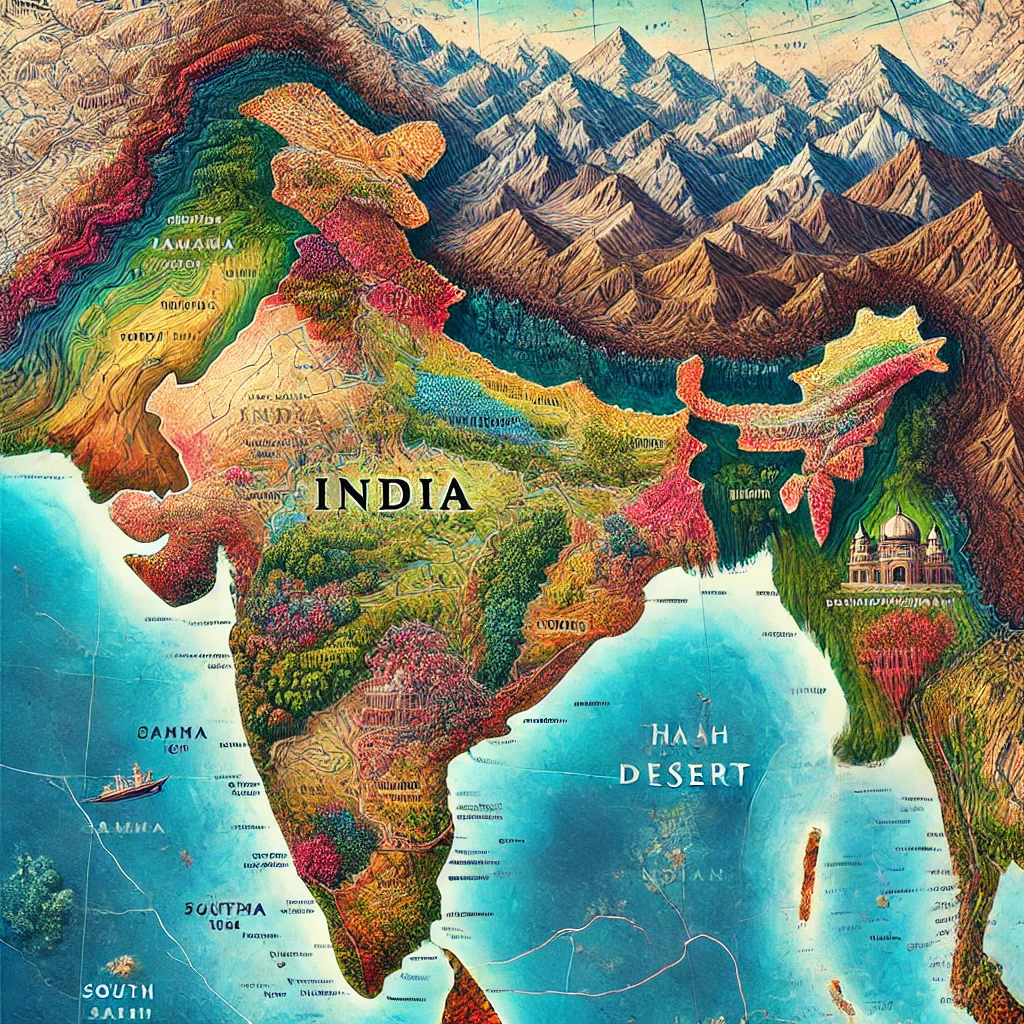
The geographical area of India is extremely diverse and is divided into different types of geographical regions. It includes mountains , plateaus , plains , deserts , coastal areas and islands. Let us understand these geographical regions in detail :
1. Himalayan Region
Status and Extent :
- It is located in the northern part of India and extends from Pakistan to Arunachal Pradesh.
- is approximately 2500 km and width up to 400 km.
Key Features :
Himalayan mountain ranges :
- Three major categories :
- Great Himalayas : This is the highest and oldest range. Mount Everest and Kanchenjunga are located in this.
- Middle Himalayas : It contains valleys and famous hill stations like Shimla , Mussoorie , and Nainital.
- Shivaliks : This is the outermost and lowest range .
- Three major categories :
Source of rivers :
- Ganga , Yamuna , Brahmaputra , Indus originate from the Himalayas.
Flora and Wildlife :
- Alpine and temperate vegetation is found here.
Importance :
- Impact on India’s climate , natural resources , water resources , and main centers of tourism.
2. Northern Plains
Status and Extent :
- This region extends from the foothills of the Himalayas to the peninsular plateau.
- It is made up of alluvial soil of rivers like Ganga , Yamuna and Brahmaputra .
Key Features :
Fertile soil of the region :
- The alluvial soil here is very fertile for agriculture.
- This region is called the ” Granary bowl of India” .
Network of rivers :
- Ganga , Brahmaputra , Sutlej and their tributaries make this region fertile .
Delta region :
- The Ganga – Brahmaputra delta ( Sundarbans ) is the largest delta in the world.
Importance :
- This region is the main source of food grain production of India.
- Its dense population and advanced irrigation system make it economically important.
3. Peninsular Plateau
Status and Extent :
- Located in the central and southern parts of India , the region is composed of old crystalline rocks.
- The Vindhya and Satpura mountains divide it into north and south.
Key Features :
Part :
- Malwa Plateau : in Madhya Pradesh and Rajasthan.
- Chota Nagpur Plateau : in Jharkhand , Odisha and West Bengal , rich in mineral wealth.
- Deccan Plateau : Located in South India , rivers like Narmada and Godavari flow through it.
Mineral Resources :
Rivers :
- Narmada , Tapti , Godavari , Krishna , Kaveri etc. are the major rivers here.
Importance :
- Important for mineral production , industrial development and hydroelectricity generation.
4. Thar Desert
Status and Extent :
- It is located in the western part of Rajasthan and also extends into parts of Gujarat , Haryana and Punjab.
Key Features :
- sand dunes :
- Extensive sand dunes are found here , which are called ” Dhariyal ” .
- climate :
- Extremely dry climate , rainfall about 150 mm per year.
- Flora and fauna :
- Thorny plants and desert animals like camels are found here.
- Irrigation Projects :
- Indira Gandhi Canal has promoted agriculture in this area.
Importance :
- Its unique culture , camel safari and desert tourism.
5. Coastal Plains
Status and Extent :
- This region is located on the eastern and western coasts of India.
- The western coast is near the Arabian Sea and the eastern coast is near the Bay of Bengal.
Key Features :
- West Coast :
- Rann of Kutch , the Konkan Coast , and the Malabar Coast.
- Ports like Mumbai , Kochi are located here.
- East Coast :
- Coromandel Coast and Northern Government Coast.
- Here are the Sundarban Delta and Chilika Lake.
Importance :
- Marine trade , fisheries and salt water related industries.
6. Island Groups
Andaman and Nicobar Islands :
- Located in the Bay of Bengal.
- These islands are made up of coral and volcanic structures.
- Cellular Jail and other tourist spots are important here.
Lakshadweep Islands :
- Located in the Arabian Sea.
- It is a coral island and a centre for fisheries.
Importance of Geographical Regions of India
- Contribution to agricultural production.
- Reserves of mineral and energy resources.
- tourism , trade and cultural diversity.
Climate of India
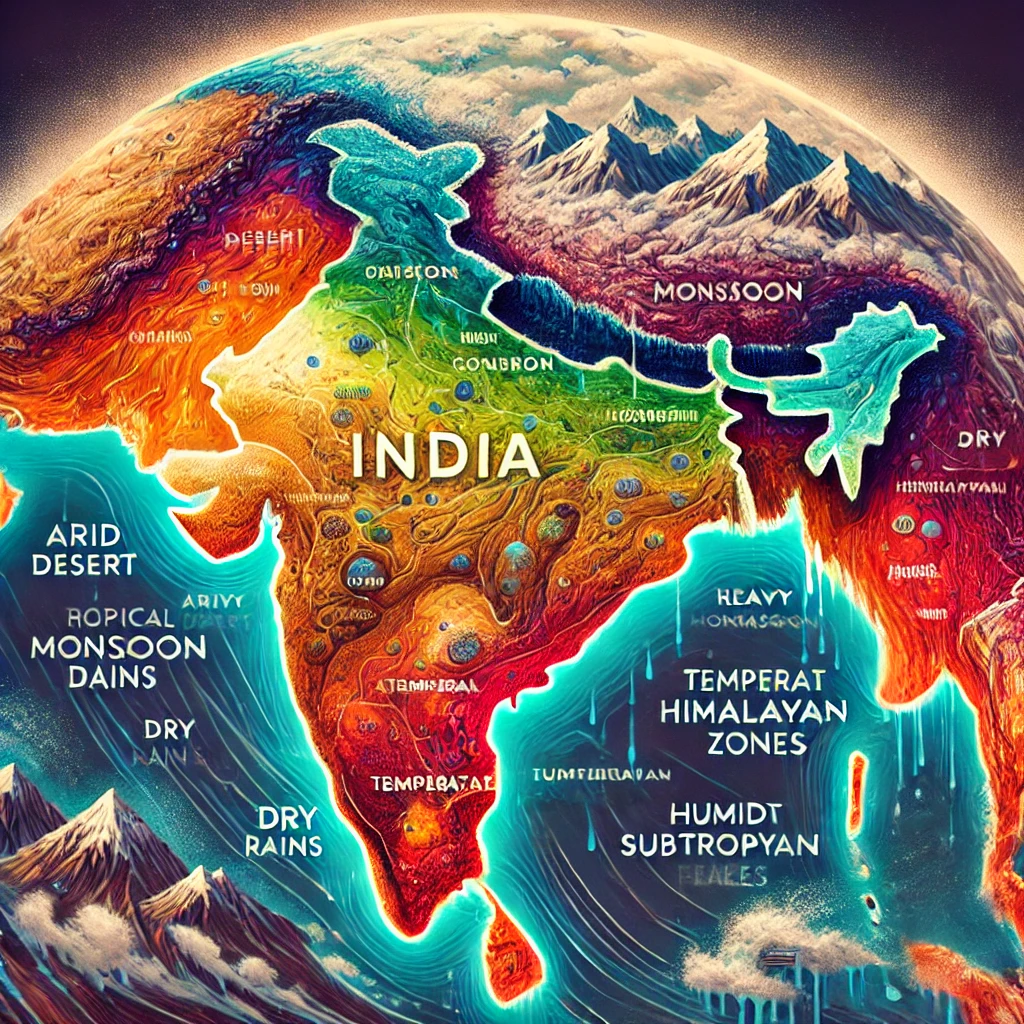
India’s climate is extremely diverse , which is due to the country’s large geographical area , varied topographical features, and the influence of the ocean. It is primarily characterized by a tropical monsoon climate. The climate in India is classified as a Mediterranean climate. There is considerable variation in the type of climate , rainfall , temperature and seasons in different parts of India.
1. Factors affecting the climate of India
India’s climate is influenced by several geographical and environmental factors :
(i) Latitudinal position
- The Tropic of Cancer passes through the middle of India , placing the southern part of the country in the tropical zone and the northern part in the subtropical zone.
- The southern region has high temperatures , while the northern region has cold winters.
(ii) Himalayan Mountains
- The Himalayas prevent cold winter waves from entering India.
- It provides a natural shield to the northern part of India.
(iii) Influence of the sea
- The sea has influence on the western and eastern coastal areas of India , due to which the climate here is temperate.
- In the interior regions the weather is more extreme due to the absence of marine influence.
(iv) Monsoon
- Monsoon is the most important component of India’s climate.
- It is influenced by the south – west monsoon and the north – east monsoon.
(v) Topography
- mountains , plateaus , plains and deserts bring diversity in the climate.
- Example : Thar Desert is dry , while cold climate is found in Himalayan region.
2. Seasons of India
The Indian climate is divided into four main seasons :
(i) Summer Season
- Duration : March to June.
- temperature :
- Northern India : 30°C to 45°C .
- South India : Comparatively less hot.
- features :
- The days are long and warm.
- Heat waves occur in the Thar Desert.
- Mountainous areas ( hill stations ) are centres of attraction for tourists in summer.
(ii) Monsoon Season
- Duration : June to September.
- Reason : South – west monsoon winds bring moisture from the Bay of Bengal and the Arabian Sea.
- features :
- Maximum rainfall occurs in the Western Ghats , North-Eastern states and Himalayan regions.
- Dry areas like Rajasthan and Gujarat receive less rainfall.
- Notable facts :
- Cherrapunji and Mawsynram ( Meghalaya ) are the rainiest places in the world.
(iii) Autumn (Post-Monsoon Season)
- Duration : October to November.
- Temperature : Slightly cold.
- features :
- The sky becomes clear with the withdrawal of monsoon.
- – east monsoon in South India causes rainfall in Tamil Nadu and Andhra Pradesh.
(iv) Winter Season
- Duration : December to February.
- temperature :
- Northern India : 5°C to 15°C .
- Southern India : Comparatively warm.
- features :
- It is extremely cold in North India.
- There is snowfall in the hilly areas.
- The climate of South India is equable.
3. Types of climate in India
The climate in India is divided into five main types in different regions :
(i) Tropical Humid Climate
- Region : Kerala , Western Ghats , Andaman – Nicobar Islands.
- features :
- High temperatures and heavy rainfall.
- Vegetation : Rain forest.
(ii) Arid Climate
- Region : Rajasthan , Gujarat , some parts of Punjab.
- features :
- Rainfall is less (100-200 mm ) .
- Thorny plants and sand dunes.
(iii) Subtropical Monsoon Climate
- Region : Ganga – Brahmaputra plains.
- features :
- Hot summers and cold winters.
- Rainfall is mainly from monsoons.
(iv) Mountain Climate
- Region : Himalayan and North – Eastern States.
- features :
- cold climate.
- Snowfall and alpine vegetation.
(v) Coastal Climate
- Region : West and East Coast.
- features :
- Humid climate.
- Less variation in temperature.
4. Monsoon and agricultural sector of India
- Effect of India’s monsoon climate on agriculture :
- About 70% of agriculture is dependent on monsoon.
- ( like paddy , maize ) are grown with the arrival of south – west monsoon .
- Rabi crops ( like wheat , gram ) are affected by the north – east monsoon.
5. Climate change and challenges in India
Effects of Climate Change :
- Unseasonal rains and floods.
- Drought and extreme heat.
- Melting of Himalayan glaciers.
Major problems :
- Decrease in agricultural productivity.
- Water crisis and impact on energy supply.
Solution :
- Adoption of climate-friendly agricultural techniques.
- Promoting renewable sources of energy.
conclusion
deeply affects its biodiversity , agriculture , and culture. Monsoon is the most important aspect of this , which affects not only agriculture but the entire economy. Addressing the problems posed by climate change will be important for India in the future.
Rivers of India
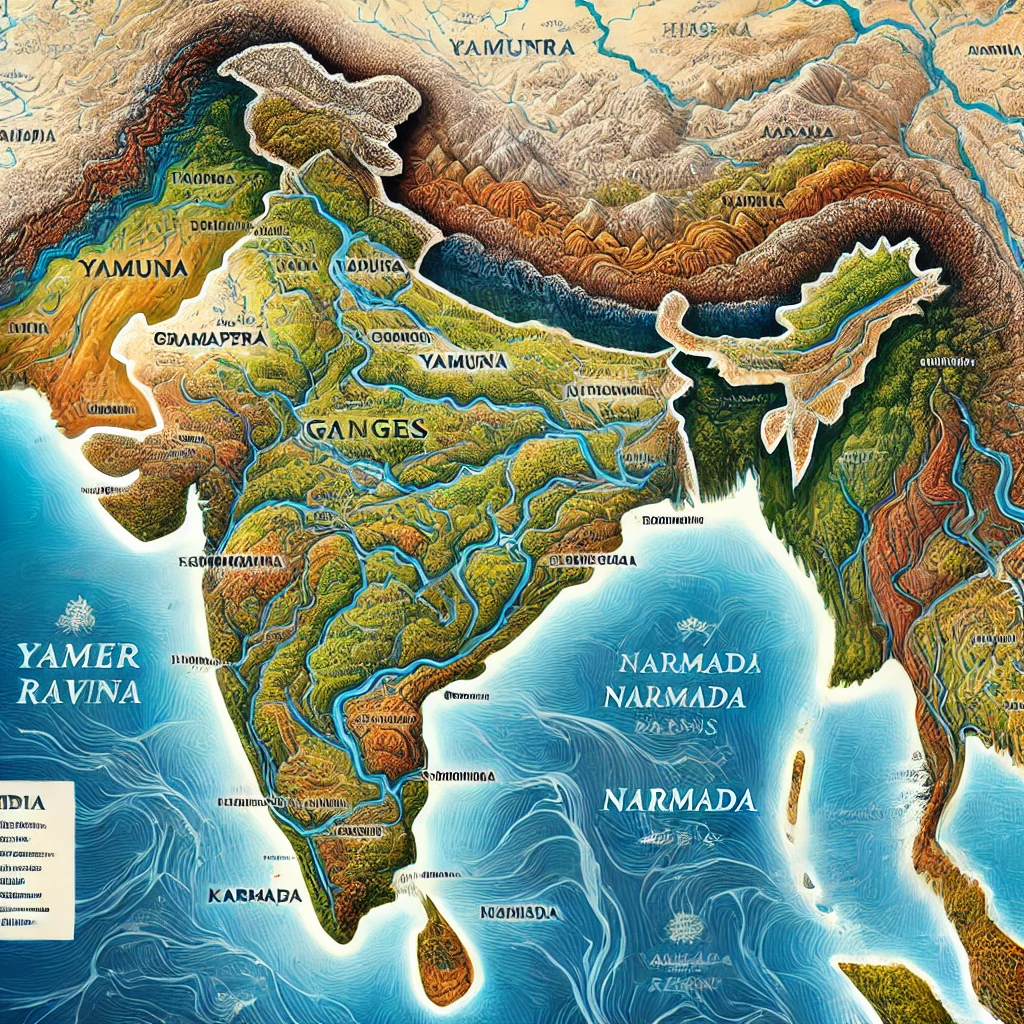
play an important role not only as a source of water but also in the development of civilization , culture , and economic activities. Indian rivers are divided into Himalayan rivers and Indian rivers. and peninsular rivers Along with these, coastal rivers and interstate rivers are also important.
1. River systems of India
(i) Himalayan rivers
- These rivers originate from the Himalayan mountains and are perennial .
- Their water comes from melting snow and monsoon rain.
- These rivers mainly form alluvial plains.
Main Himalayan rivers :
Ganga River System :
- Source : Gangotri Glacier ( Uttarakhand ) .
- Important tributaries :
- Right bank tributaries : Yamuna , Son.
- Left bank tributaries : Ghaghra , Kosi , Gandak.
- features :
- The longest river of India (2525 km ) .
- This makes the plains of North India extremely fertile.
- Delta : Sunderbans delta of Ganges – Brahmaputra.
Brahmaputra River System :
- Source : Mansarovar Lake ( Tibet ) .
- is called ” Brahmaputra ” in Assam and Arunachal Pradesh .
- features :
- This river forms a large delta.
- Problem of flooding and soil erosion during monsoon.
Indus River System :
- Source : Lake Manasarovar in Tibet.
- Important tributaries : Jhelum , Chenab , Ravi , Beas , Sutlej.
- features :
- The Indus River passes through Pakistan and falls into the Arabian Sea.
- 20% of it is in India .
(ii) Peninsular rivers
- These rivers originate from the peninsular plateau.
- Most of the rivers are rain-fed and are therefore seasonal.
- create deep valleys and waterfalls .
Main Peninsular Rivers :
Narmada River :
- Source : Amarkantak ( Madhya Pradesh ) .
- This is the largest river of India falling into the Arabian Sea.
- It is one of the ” west -flowing” rivers.
- Famous Waterfall : Dhuandhar.
Tapti River :
- Source : Satpura Mountains ( Madhya Pradesh ) .
- It flows parallel to the Narmada River and falls into the Arabian Sea.
Godavari River :
- Source : Trimbakeshwar ( Maharashtra ) .
- It is also called ” Dakshin Ganga ” .
- Length : 1465 km.
- It falls into the Bay of Bengal.
Krishna River :
- Source : Mahabaleshwar ( Maharashtra ) .
- Length : 1400 km.
- Famous Dam : Nagarjuna Sagar Dam.
Cauvery River :
- Source : Brahmagiri Hills ( Karnataka ) .
- It is the lifeline of Tamil Nadu and Karnataka.
- Famous Place : Hogenakkal Falls.
Mahanadi :
- Source : Chhattisgarh.
- Length : 858 km.
- Hirakud Dam ( Odisha ) is built on this river.
(iii) Coastal rivers
- These rivers flow in the coastal areas and are small.
- The rivers of the west coast are short and fast flowing.
- The rivers of the east coast are longer and form large deltas.
2. Economic and cultural importance of Indian rivers
(i) Contribution to agriculture
- Indian rivers are the main source of irrigation.
- The Ganges – Brahmaputra plain is highly fertile for agriculture.
- Major crops : Rice , Wheat , Sugarcane.
(ii) Hydroelectric power generation
- Hydroelectric projects are underway on the Narmada , Sutlej , and Brahmaputra rivers.
- Famous Dams : Bhakra Nangal , Hirakud.
(iii) Transport and trade
- Rivers have been a major means of transportation and trade since historical times.
- Inland Water Transport System on River Ganga.
(iv) Cultural and religious importance
- The Ganga , Yamuna , and Saraswati rivers are considered sacred in Indian culture.
- Kumbh Mela and other religious rituals take place on the banks of rivers.
3. Environmental problems related to rivers
Pollution
- Increasing levels of industrial waste , sewage and plastic in rivers.
- Rivers like Ganga and Yamuna suffer from the problem of pollution.
(ii) floods and droughts
- Flooding of rivers during monsoon.
- Drought due to lack of rain.
(iii) Encroachment on rivers
- Illegal construction on river banks.
- Change in water level of rivers due to climate change.
4. Efforts to save rivers
- Ganga Rejuvenation Plan (Namami Gange Programme) :
- To make the Ganga river clean and pollution free.
- Measures to tackle climate change :
- Tree plantation and rain water harvesting.
- Construction of Dams and Reservoirs :
- For water management.
conclusion
India’s rivers are not just water resources ; they are the country’s economic , cultural , and religious lifeline. Conservation of rivers and ensuring their sustainable use is vital for the country’s development and environmental balance.
Forest and Vegetation Regions of India
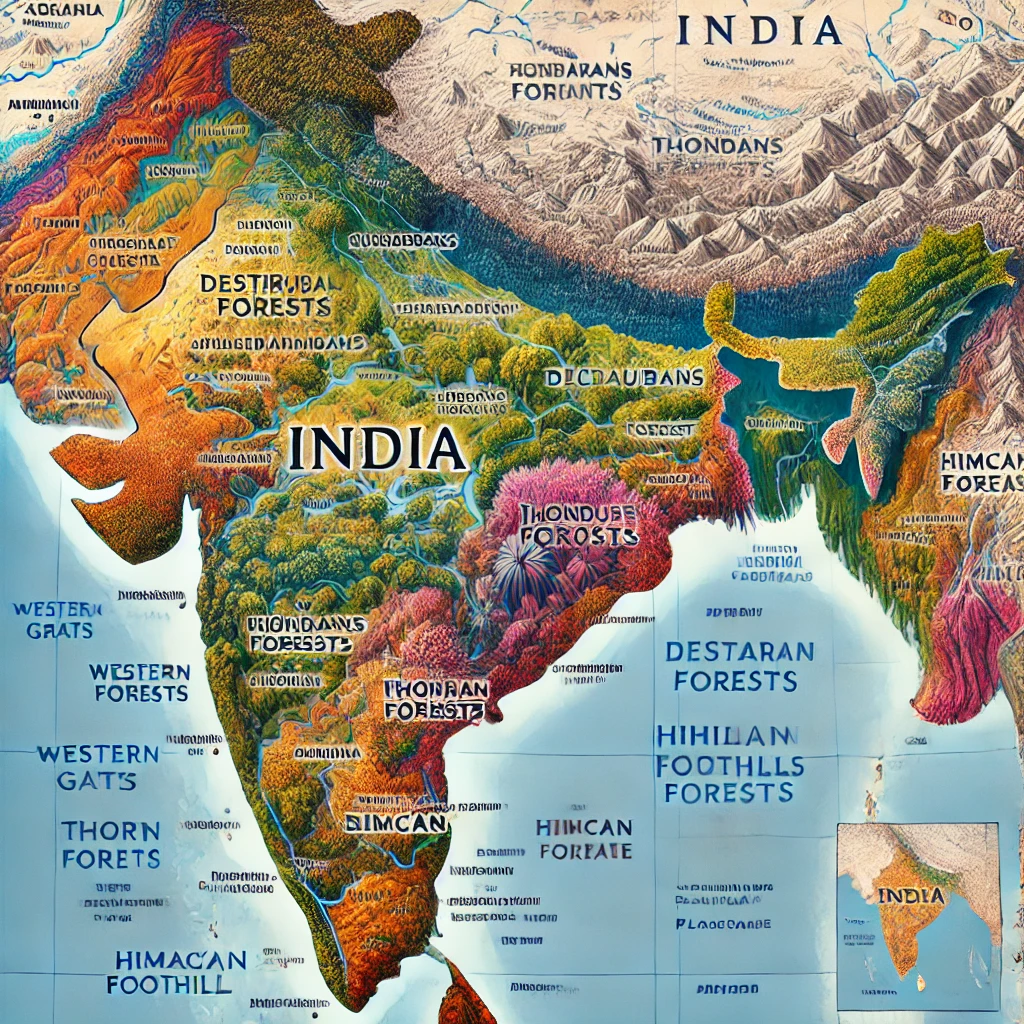
India’s forest and vegetation area is the main basis of its biodiversity , environmental balance , and economic resources. Due to the diverse climate , soil , and topography, there is a lot of diversity in vegetation here. To understand forests and vegetation in India, it has been classified into different types.
1. Forest Area in India
(i) Forest Cover
- 21.71% of the total geographical area of India Part is covered with forests ( according to recent data ) .
- Maximum forest area : Madhya Pradesh , Arunachal Pradesh , Chhattisgarh.
- Classification of forests on the basis of density :
- Dense forest : More than 70% tree cover.
- Medium density forests : 40%-70% tree cover.
- Open forests : 10%–40% tree cover.
(ii) Importance of forests
- environmental benefits :
- Absorbing carbon dioxide.
- Maintaining biodiversity.
- Conservation of soil and prevention of soil erosion.
- Economic benefits :
- Source of materials such as timber , paper , medicinal plants , and rubber.
- Support to forest-based industries.
- Social and Cultural Importance :
- The basis of livelihood of tribal communities.
- Part of religious and cultural sites.
2. Types of Forests in India
Forests are classified on the basis of climate , soil , and topography. Mainly the following types of forests are found in India :
(i) Tropical Rain Forests
- Location : Western Ghats , Andaman – Nicobar Islands , Assam , and North-Eastern States.
- features :
- High temperature and heavy rainfall (200 to 250 cm ) .
- Evergreen Trees .
- Major trees : Mahogany , Rosewood , Ebony.
- Rich in biodiversity.
- Importance : Home to medicinal plants and rare wildlife.
(ii) Tropical Deciduous Forests
- Location : Madhya Pradesh , Uttar Pradesh , Chhattisgarh , Jharkhand.
- features :
- Rainfall : 100-200 cm.
- Dry and wet deciduous species.
- Major trees : Sal , Teak , Shisham , Acacia.
- Importance : Source of wood for agriculture and construction purposes.
(iii) Tropical Thorn Forests
- Location : Rajasthan , Gujarat , Haryana , Punjab.
- features :
- Rainfall : 50-100 cm.
- Thorny bushes and plants.
- Main trees : Acacia , Khejari , Khair.
- Importance : Soil conservation in arid and semi – arid areas.
(iv) Montane Forests
- Location : Himalayas and high mountain regions of South India.
- features :
- Variety based on height.
- Temperate and alpine vegetation.
- Major trees : Cedar , Pine , Spruce.
- Importance : Environmental balance and tourism.
(v) Mangrove Forests
- Location : Sunderbans ( West Bengal ), Andaman – Nicobar.
- features :
- Found in brackish water and tidal areas.
- Major tree : Sundari tree in Sundarbans.
- Importance : Coastal protection and biodiversity.
3. Major Vegetation in India
The flora of India shows wide diversity due to diverse climate , soil , and topography .
(i) Natural Vegetation
- Based on the climatic zone and soil of the country.
- Including evergreen vegetation to thorny plants.
(ii) Agricultural Vegetation
- Crops like wheat , rice , sugarcane , maize.
- Production of fruits and spices.
(iii) Medicinal Plants
- Tulsi , Neem , Amla , and Ashwagandha.
- Uses in traditional medicine and Ayurveda.
4. Need for Conservation of Forests and Vegetation
Reasons for Destruction of Forests :
- Deforestation .
- Urbanization and industrialization.
- Forest fires and encroachment.
Conservation Measures :
- Regenerating forests.
- Conducting tree plantation programmes.
- Creation of reserved and protected forests.
- Public awareness campaign.
Government efforts :
- National Forest Policy : Target to increase forests to 33% .
- Sensitive area protection : Biosphere reserves , national parks and wildlife sanctuaries.
5. Impact of climate change on forests and vegetation
- Global warming :
- Due to increasing temperature, some plants and species are at risk of extinction.
- Decrease in rainfall :
- Lack of moisture in tropical forests.
- Effects on wildlife :
- reduction of their natural habitat.
conclusion
India’s forests and vegetation not only maintain the country’s environmental balance , but are also the main source of resources necessary for human life. Conservation of forests and ensuring their sustainable use should be our priority.
Natural Resources of India
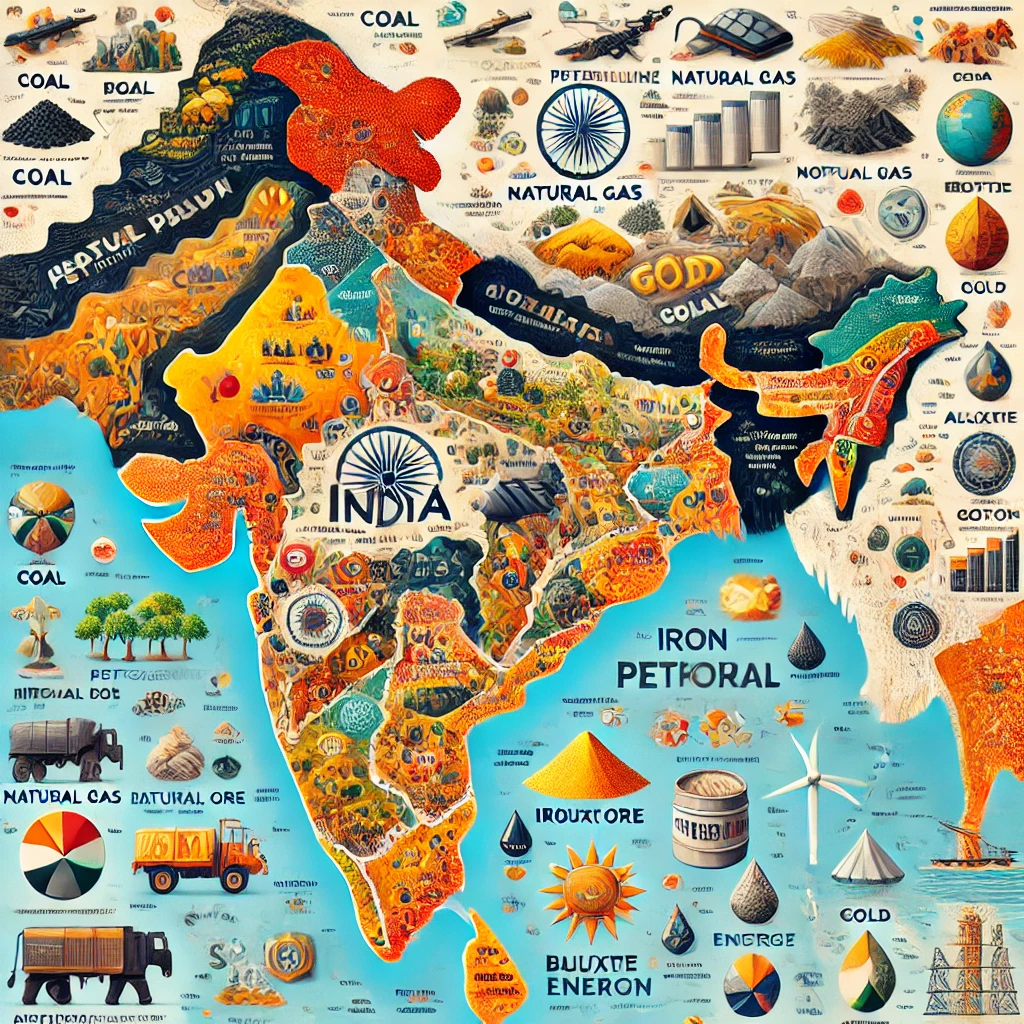
Natural Resources They are resources that are obtained from nature and are useful for human life. These resources are vital for the existence and development of life on earth. India is a rich country in terms of natural resources.
1. Classification of Natural Resources
(i) On the basis of source
Biotic Resources :
- Obtained from living sources.
- Examples : Plants , animals , wood , food items .
Resources :
- Obtained from non-living sources.
- Examples : Minerals , water , air , soil.
(ii) On the basis of renewability
Renewable Resources :
- which can regenerate over time.
- Examples : Solar energy , wind , water , forests.
Resources :
- which expire after one use and are not regenerated.
- Examples : Minerals , coal , petroleum , natural gas.
(iii) On the basis of distribution
Resources :
- Which are found in every part of the earth.
- Example : Air , water , sunlight.
Resources :
- Which are available only at special places.
- Example : Minerals , Petroleum.
(iv) On the basis of usage
Raw Materials:
- Resources used in industries.
- Example : Iron ore , bauxite.
Resources :
- Resources created by processing raw materials.
- Example : Steel , Petrol.
2. Major Natural Resources of India
(i) Water Resources
Water sources in India :
- Rivers : Ganga , Yamuna , Godavari.
- Lakes : Chilika Lake , Wular Lake.
- Groundwater : Major source of irrigation and drinking water.
Importance :
- Irrigation , hydropower , drinking water.
- Essential for agriculture and industries.
(ii) Land Resources
Total land of India : 32.87 lakh sq. km.
land use :
- Agriculture : about 54% .
- Forest : 21.71% .
- Barren and unused land.
Importance :
- Agriculture , housing , industry , vegetation.
(iii) Forest Resources
- Forest Cover : About 21.71% of India’s land area is covered with forests.
- Types : Tropical , Deciduous , Montane , Mangrove.
- Use :
- Timber , rubber , medicinal plants.
- Conservation of biodiversity.
(iv) Mineral Resources
India is a major producer of minerals.
Major minerals and their location :
- Iron Ore : Odisha , Jharkhand.
- Coal : Jharkhand , Chhattisgarh.
- Petroleum : Assam , Gujarat.
- Bauxite : Odisha.
Use :
- Energy production.
- industrial development.
(v) Energy Resources
Sources :
- Coal , petroleum , natural gas.
- For thermal power and transportation.
Sources :
- Solar energy , wind energy , tidal energy.
- Environment friendly.
(vi ) Biodiversity
- ranks 7th in the world in biodiversity .
- Benefits :
- Source of medicinal plants.
- Maintaining environmental balance.
3. Importance of Natural Resources
- Economic Development :
- Use of resources for agriculture , industry , and energy.
- Support of human life :
- Supply of food , water , and energy.
- Environmental Balance :
- Conservation of forests and climate.
- scientific research :
- Development of new technologies and medicines.
4. Problems of Resource Exploitation
- Lack of Afforestation :
- Indiscriminate cutting of forests.
- Overexploitation of minerals :
- Uncontrolled use of mineral resources.
- Water crisis :
- Water pollution and wastage.
- Environmental imbalance :
- Increase in greenhouse gases.
5. Conservation of Natural Resources
(i) Conservation of water resources :
- Rain water harvesting.
- Preventing wastage of water in irrigation.
(ii) Forest conservation :
- Preventing deforestation.
- Tree plantation and social afforestation.
(iii) Energy conservation :
- Use of solar and wind energy.
- Use of energy efficient appliances.
(iv) Conservation of Mineral Resources :
- Recycling of minerals.
- Ensuring their sustainable use.
6. Sustainable Use of Natural Resources
- Balanced use :
- Preventing unnecessary exploitation of resources.
- Use of natural energy :
- Promoting unconventional energy sources.
- Education and awareness :
- To make people aware about conservation of resources.
conclusion
Natural resources are an integral part of our lives. Their conservation and sustainable use is essential not only for our present generation but also for future generations. It is our responsibility to use these resources judiciously and maintain environmental balance.
Geographical importance of India
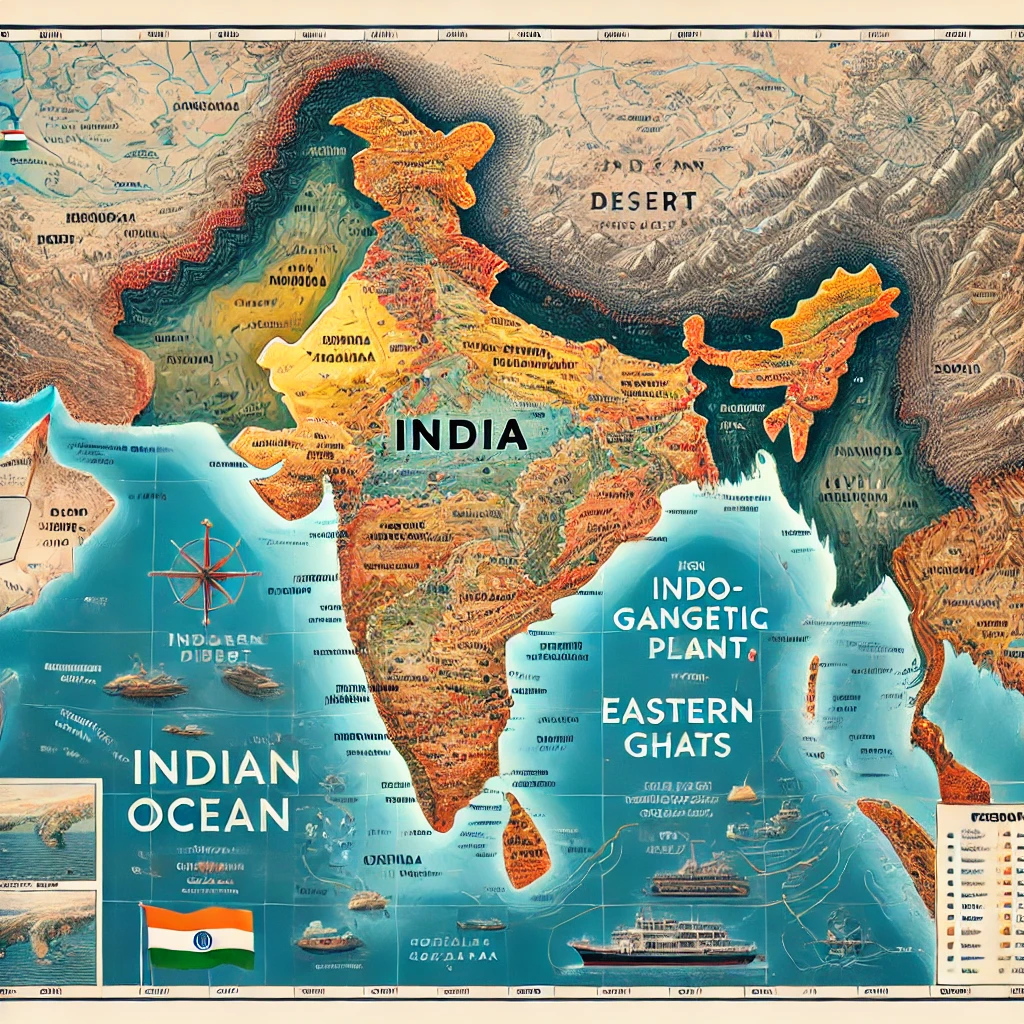
Geographical Importance Geography defines the social , economic , cultural and political role of a region , place , or country based on its location , physical features , climate , natural resources , and strategic location . India’s geographical importance gives it a prominent position on a global scale.
1. Geographical Importance of India
(i ) Geographical Location :
- India is situated in the Northern Hemisphere from 8°4’N latitude to 37°6’N latitude and from 68°7′ East Longitude to 97°25′ East Longitude It is situated between.
- The Tropic of Cancer passes through the middle of India , dividing it into tropical and subtropical regions.
- Arabian Sea to the east and west of India and the Bay of Bengal , making it a semi – island country It is made.
- Himalayas in the north and the Indian Ocean to the south It is provided with natural protection and waterways.
(ii ) Land Size :
- India has an area of 32.87 lakh square km , making it the seventh largest country in the world Makes it.
- It has a border of 15,200 km of land border and 7,517 km of sea border.
(iii) Strategic Location :
- India is located in the southern part of Asia and is known as the ” Heart of Asia “. It is believed.
- is located on a major trade route between Europe , Africa , and Asia.
- Centre of sea routes : Strait of Malacca near India and the Suez Canal It has access to the world’s major sea routes through.
2. Aspects of the geographical importance of India
(i) Effect of climate :
- The geographical location of India gives it monsoon climate provides.
- Being located in the tropical region , the climate is suitable for an agriculture-based economy.
(ii) Availability of natural resources :
- India’s geographical area is blessed with a variety of soil , minerals , and water resources.
- Rivers originating from the Himalayas , such as the Ganges , Brahmaputra , Indus , and rivers of South India such as the Godavari and Kaveri , contribute to agriculture and hydroelectric power generation.
(iii) Cultural diversity :
- Geographical diversity has given rise to different languages , religions , and cultures.
- The Himalayas in the north , the Dravidian culture in the south , and the desert regions in the west display diverse cultural characteristics.
(iv) Border security and strategic importance :
- The Himalayas provide natural protection to the northern region of India.
- India’s geographical location with countries like Pakistan on the western border , China on the northern border , and Myanmar in the northeast makes it a political and diplomatic asset. Makes it important.
(v) Trade and Transport :
- India’s major ports , such as Mumbai , Chennai , Kolkata , and Cochin , facilitate international trade.
- Its position makes it a major trading hub between Asian , African , and European markets.
(vi) Agricultural and Industrial Importance :
- India’s climate and soil make it ideal for agricultural production.
- Major crops : Rice , wheat , sugarcane , cotton.
- Availability of mineral resources also helps it in industrial development.
3. Global impact of India’s geographical location
(i) Leadership in South Asia :
- India’s geographical location makes it a major power for South Asian countries.
- Influence of India on neighbouring countries : Nepal , Bhutan , Sri Lanka , Bangladesh.
(ii) Importance in the Indo – Pacific region :
- India’s position allows it to play a major role in the Indo – Pacific region.
- Maritime trade and its contribution to security.
(iii) Environmental contribution :
- Importance of Himalayas : It is the source of major rivers of Asia.
- India’s forests and biodiversity help maintain global climate balance.
4. Challenges of India’s geographical importance
Border dispute :
- Border dispute with Pakistan and China.
- Infiltration and unrest in North-East India.
Natural Disasters :
- Landslides and glacier melt in the Himalayas.
- Cyclones and floods in coastal areas.
Environmental imbalance :
- Deforestation and pollution.
- Impact of climate change.
5. Measures to Enhance India’s Geographical Importance
(i) Border Security :
- High-tech security and border surveillance.
(ii) Sustainable use of resources :
- Judicious use of water , land , and mineral resources.
(iii) Development of trade and transport :
- Expansion of ports and transport network.
- Promote trade agreements with neighboring countries.
(iv) Environmental protection :
- Forest conservation and use of green energy.
- Preparedness to reduce the impact of natural disasters.
conclusion
India’s geographical importance not only makes it economically and strategically important , but it also defines its cultural and environmental contributions. Its geographical location and diversity give it an influential place on the global stage.